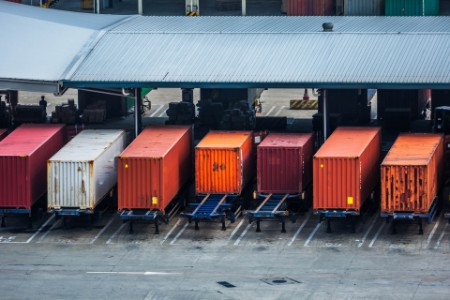
Chapter 1
Traditional supply chain models are broken
Leaders who want to be in business tomorrow must rethink the role of China in their supply chains today.
With some of the world’s most advanced manufacturing capabilities, sought-after skills and a rising middle class, China is no longer a low-cost base. Edvard Rinck, EY Asia-Pacific Operating Model Effectiveness Leader, says, "The 'factory of the world' is moving up the value chain; leaders who want to be in business tomorrow must rethink the role of China in their supply chains today." Here’s how:
1. China Plus One
Rising wages and the Chinese Government’s policy objectives send clear signals that MNCs should focus on leveraging China’s high-end manufacturing base, while moving lower-end products elsewhere. Whether it’s the manufacture of masks, makeup or microchips, having supply chain options in China and at least one other market ensures MNCs can have the best of both worlds.
2. Expectation acceleration
Customers in some Chinese cities now expect to purchase a product on a social media platform and have it on their doorstep in just 30 minutes. Meeting these expectations is at the heart of managing your supply chain in the world’s most dynamic e-commerce market.
3. China-for-China
With Chinese consumers increasingly turning toward local brands, global companies must work harder to capture their slice of the consumer pie. The Government is encouraging MNCs and foreign research institutions to establish local design and talent training centers, demonstration factories and collaborations with Chinese companies.
The 'factory of the world' is moving up the value chain; leaders who want to be in business tomorrow must rethink the role of China in their supply chains today.
4. The super connector
Hong Kong remains China’s window on the world, and the world’s window on China. The Outline Development Plan for the Guangdong-Hong Kong-Macao Greater Bay Area (GBA) in 2019 has deepened cooperation, and a well-developed transportation network has enhanced connections. With the robust development of GBA, more and more MNCs are looking to elevate their presence in the area.
5. Target tiers
Chinese cities are categorized into four tiers, ranging from the largest and most developed urban metropolises in the first tier (GDP of more than US$300 billion and population greater than 15 million) to the smaller, less developed but often fast-growing cities in the fourth tier. Companies must think carefully about their target cities to maximize their presence in the market.
6. Sustainability matters
In May 2021, the Chinese Government announced a US$1.4 trillion investment in "new infrastructure" over the next five years to fund low-carbon technologies from electric vehicle charging and high-speed rail to long-distance power transmission that promise to bring renewable power to cities. Regulations also are changing at lightspeed.
MNCs cannot rely on global legacy systems, processes and product strategy. Instead, they must reshape and reconfigure their entire supply chain strategy to reflect the change.

Chapter 2
Businesses need a future-focused corporate governance structure
A company structure that served you well for decades may now miss the mark in the world’s largest consumer market.
The Government is looking at companies through a distinctively Chinese ESG lens. The message for MNCs is crystal clear. The Chinese Government doesn’t want to constrain companies from making money in China; it wants to see companies that make money in China reinvest their fair share back into the Chinese society. Future success depends on robust and resilient company structures that ensure profits made in China are fairly reinvested in China. MNCs must critically evaluate their business models beyond the purely financial, and look to grow new markets and capabilities synergies. It can use tax policy as a lever.
Special tax treatments for foreign employees, such as tax exemptions for benefits like children’s school fees, rent and language courses, were expected to change starting from 2022 when the China government implemented its individual income tax transformation in 2019 – which may make it more difficult for MNCs to attract talent. However, on 31 December 2021, the Ministry of Finance and State Taxation Administration announced that the tax exemptions for foreign expatriates will be extended for two more years (until 31 December 2023). This provides a positive signal in terms of talent recruitment, while the uncertainty of such special tax treatments after a two year period could still have an impact on the attraction of talents to China in the long term.
Western companies with strong brands, products and services aligned to Chinese tastes, and supply chains tuned to achieve high service levels, are realizing good profits.
The Government continues to look favorably on companies that establish their Asia-Pacific headquarters in China, set up research and development (R&D) hubs in special economic zones, partner with universities or create job opportunities for the next generation of Chinese talent. When MNCs structure their operations in the right way, all sorts of tax benefits and subsidies are on the table.
Alex Lee, EY Asia-Pacific Customer & Growth Leader, explains, “Western companies with strong brands, products and services aligned to Chinese tastes, and supply chains tuned to achieve high service levels, are realizing good profits. These companies have also designed their tax structure, transactional model and legal framework to realize the best after-tax results and route the cash to where it is needed – often in China itself to support further expansion.”

Chapter 3
A trilogy of laws is turning up the heat on tech
A fluid technology roadmap is the only solution to meet the needs of China consumers, and ever-evolving laws in China and around the world.
A “trilogy” of new laws will provide a unified protection regime in a country which, some analysts estimate, is home to 40% of the world’s data.
The first in this trilogy, the Cybersecurity Law, was introduced in June 2017.
The Data Security Law (DSL), which came into force on 1 September 2021, and its companion, the Personal Information Protection Law (PIPL) which took effect on 1 November 2021, round out the trilogy. The DSL is focused on activities involving data processing, and the PIPL zeroes in on personal information.
Unlike the existing regulation of the domestic internet, which manages external information inflow into China – these new laws also protect data outflows. Each law features approaches that aren’t always easy to navigate, and implications that require most Western companies to change the way they collect, store, transmit and use data generated in China.
MNCs looking to enter the China market cannot simply rollout their systems without giving due consideration to these new regulatory requirements.
As just one example, the law emphasizes “important data” as well as “personal information.” The Government considers information “important” if it relates to anything likely to influence national security, the broader economy or the public interest. “Personal information” or “important data” collected within China must be stored within China. To remain compliant, MNCs that currently transmit data to overseas headquarters must restructure their data transfer mechanisms and undertake a security assessment to gain approval to send any “important data” offshore.
Richard Watson, EY Global and Asia-Pacific Cybersecurity Consulting Leader, states that “MNCs looking to enter the China market cannot simply roll out their systems without giving due consideration to these new regulatory requirements.” Remaining compliant with regulation demands a clear China technology roadmap.

Chapter 4
Top talent is looking locally, not globally
What works elsewhere may not work in China. The employment market is unique and MNCs must be prepared to localize, adapt and innovate.
Attracting young local talent in China has never been easy for MNCs. But historically they had a big advantage: graduates viewed them as high-status employers of choice with generous salary packages, lots of training resources and global career prospects.
Today, a high proportion of Chinese talent – especially those in the technology sector – are starting to recognize Chinese employers as their best bet. Chinese companies tick a lot of boxes, often offering more attractive remuneration and equity incentives, flatter corporate structures that fast-track careers, and dynamic and exciting work on the cutting edge of technology.
Then there’s the scale of the talent attraction and incubation programs that some Chinese companies can offer. Western multinationals might hire a handful of graduates in China each year, while just one local tech titan might hire 10,000.
To compete in China, multinationals must tailor an approach that fulfills the workforce both now and into the future.
At the same time, China’s taxation and regulatory environment is evolving. China has always offered sweeteners for foreign talent, with tax-free fringe benefits like housing costs and children’s education. But recent tax reform has sought to create a more balanced employment environment. In the future, employees will also be obliged to participate in the social security scheme, which has been optional for foreign nationals. For some, this will shave off around 10% from foreign nationals’ salaries.
While there are still some tax incentives available, depending on the city, the tax authority is stepping up its monitoring. MNCs that don’t comply with the new rules face steep penalties and reputational damage – and they may find it harder to lure foreign talent to China.
The biggest challenge for most MNCs is to move away from a single, global approach to talent management.
Kannie Kong, Partner, People Advisory Services, Ernst & Young (China) Advisory Limited, emphasizes that “Chinese tech companies are changing the talent atmosphere, and multinationals in every sector now face a fierce war for talent. To compete, multinationals must tailor an approach that fulfills the workforce both now and into the future: begin with a clear talent management strategy; think holistically about what you can offer young talent across the five Ps of pay, performance evaluation, promotions, incentive programs and profit-sharing schemes; hire the right mix of talent, with a focus on those who understand business in China, speak the language and know the customer; and consider your geography – Shenzhen or Guangzhou might not prove as attractive as Shanghai, for instance.”
Stephen Koss, EY Asia-Pacific Workforce Advisory Leader, adds: “The biggest challenge for most MNCs is to move away from a single, global approach to talent management.”

Chapter 5
Chinese customers expect more than ever before
Copying other strategies and applying them in China will not work - operations must connect to local innovation ecosystems and customers.
In a market developing a preference for domestic brands, especially when there is little perceived difference in product quality, MNCs can be taken by surprise. As Ignatius Tong, EY-Parthenon Asia-Pacific Leader, says, “If you produce shoes in San Francisco or leisurewear in London, it won’t necessarily sell in China.”
Generation Z – born between the late 1990s and the early 2010s – makes around 50% of all purchases of luxury goods in China, despite accounting for 15% of the population. This massive market of 210 million people is not interested in luxury for luxury’s sake. They want personalization, individualization and bespoke experiences. Almost half (48%) of consumers expect to spend more on experiences in the future – much higher than the global average, according to the EY Capital Confidence Barometer.
If you produce shoes in San Francisco or leisurewear in London, it won’t necessarily sell in China.
Where is the trendline pointing? We think MNCs should have their focus on four consumer trends driven by technology:
1. Online, offline, omni-channel
Online retail sales revenue reached RMB9.8 trillion in 2020, accounting for 24.9% of total retail sales, clearly demonstrating the Chinese shopping journey starts online. As China has a unique digital channel landscape with many different identities and characteristics, it is important to design a digital channel portfolio and a connected experience between channels.
2. Evolving the super app
In China, a single entry point fulfills every purchasing need, as well as other functions from coupon collection, payment to chat groups. Some MNCs have recognized they need more than standalone apps to sell to China’s consumer and are forging partnerships with e-commerce giants to reach shoppers at the early stages of their purchase decisions. They are also taking their cues from the seamless online experience expected in China to create immersive offline experiences.
3. Live commerce learnings
Chinese consumers like to make real-time purchases while watching live demos and interacting with the host. The trend reached a tipping point in 2019 when total live commerce sales exceeded RMB434 billion (around US$63 billion), accounting for 4.1% of China’s total retail e-commerce sales.
4. Empowered by emerging technologies
Augmented and virtual reality, artificial intelligence and livestreaming content are continuously evolving in China to create an interactive consumer experience.
China has a population that lives on mobile devices and will likely soon use pure digital currency. This makes it imperative that MNCs align with local technology partners.
Alex Andrenacci, EY Asia-Pacific Consulting Technology Leader, says that “China is the largest e-commerce market in the world, has a population that lives on mobile devices and will likely soon use pure digital currency. This makes it imperative that MNCs align with local technology partners and deeply understand the local purchasing demands and expectations of consumers.”
Some of the headaches on the horizon will be resolved in two years; others may take 10. But business leaders who think it is smart strategy to let others feel their way first may miss out on the China market forever. Chinese customers expect companies to respond and meet their needs immediately – not within days, but within hours.
The policies referred to in this article are accurate as of 31 December 2021. For the latest updates, please contact the EY team.
The following people also contributed to this article:
Alice Chung, Executive Director, International Tax and Transaction Services, Ernst & Young Tax Services Limited
Nelson Chow, Partner, Supply Chain & Operations Consulting, Ernst & Young Advisory Services Limited
Scott Chen, Associate Partner, Supply Chain & Operations, Ernst & Young (China) Advisory Limited
Atul Chandna, EY Asia-Pacific Supply Chain & Operations Leader
Rodrigo Cambiaghi, Managing Partner, Consulting, Ernst & Young Assessoria Empresarial Ltda
Charles Yeo, Partner, Technology Consulting, Ernst & Young (China) Advisory Limited
Sunny Liew, Associate Partner, Regulatory & Compliance Advisory Services, Ernst & Young (China) Advisory Limited
Maureen Chio, Partner, People Advisory Services, Ernst & Young (China) Advisory Limited
Kannie Kong, Partner, People Advisory Services, Ernst & Young (China) Advisory Limited
Sharry Wu, EY Greater China Consulting Business Transformation Leader
Kelvin Gao, EY Greater China Cybersecurity Leader
Summary
Running with an outmoded China strategy is a risky proposition. Even riskier? Thinking you don’t need a China strategy at all.
With the right strategy in place, you will be able to navigate above the noise.


